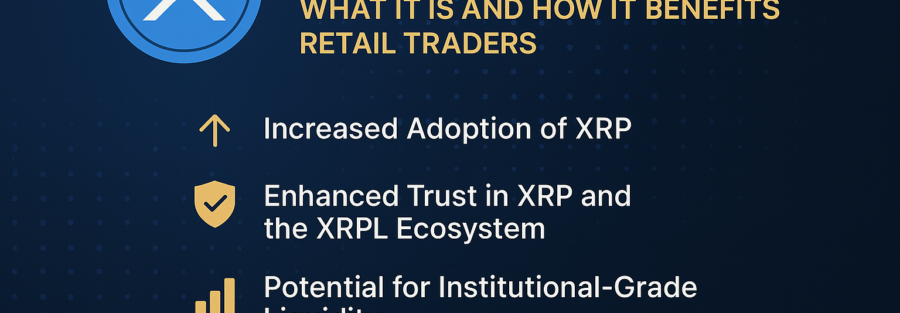Introduction
Cryptocurrency has transformed the world of finance, providing fast, decentralized, and secure ways to transfer value. Among the top players in this space is Ripple and its native token, XRP. Ripple has long been associated with cross-border payments and financial innovation. One of its more advanced offerings is the XRP Private Ledger, a lesser-known but powerful tool designed with institutional-grade privacy and scalability in mind.
But how does this private ledger benefit retail traders like you and me? In this comprehensive post, we’ll explore what the XRP Private Ledger is, its key features, and most importantly, how it can indirectly offer exciting advantages to retail traders in the crypto space.
What is the XRP Private Ledger?
The XRP Private Ledger is a specialized version of Ripple’s XRP Ledger (XRPL) designed specifically for central banks, financial institutions, and enterprises. While the public XRP Ledger is already known for its speed, low transaction fees, and reliability, the private version takes these features a step further with added privacy and scalability.
Ripple introduced the private ledger as a solution for institutions that need a confidential, efficient, and secure blockchain to issue and manage digital assets, particularly Central Bank Digital Currencies (CBDCs).
Key Features of the XRP Private Ledger
- Privacy & Confidentiality
- Transactions on the XRP Private Ledger are not visible to the public.
- This feature is crucial for banks and governments who need to protect sensitive financial data.
- High Scalability
- The private ledger can handle tens of thousands of transactions per second (TPS).
- This makes it far more efficient than traditional banking systems and most public blockchains.
- Minimal Transaction Costs
- Like the public XRP Ledger, the private ledger keeps fees extremely low.
- This allows for micro-transactions and high-volume operations without breaking the bank.
- Interoperability with Existing Financial Systems
- The XRP Private Ledger is designed to connect seamlessly with existing financial infrastructure.
- It can also integrate with the public XRP Ledger when needed, offering flexibility and wide-reaching capabilities.
- Support for Central Bank Digital Currencies (CBDCs)
- The private ledger is built with CBDC development in mind.
- Countries and institutions can issue, manage, and transact their own digital currencies securely.
Why Was the XRP Private Ledger Created?
Ripple created the private ledger to address the limitations of public blockchains for institutional use. Public blockchains, while transparent and decentralized, can pose challenges for enterprises that require data confidentiality and regulatory compliance.
The XRP Private Ledger offers a customized environment where transactions are protected, performance is maximized, and regulatory frameworks can be more easily integrated. It’s Ripple’s answer to the growing demand for enterprise-grade blockchain solutions.
How Does the XRP Private Ledger Work?
The private ledger operates similarly to the public XRP Ledger but in a closed environment. It uses the same core consensus algorithm, ensuring that transactions are fast and final. Validators in the private network are permissioned, meaning only approved participants can validate transactions. This boosts both efficiency and security.
Additionally, because it’s based on XRP technology, the private ledger supports cross-border payments, asset issuance, and tokenization, making it a flexible tool for financial institutions worldwide.
Benefits of the XRP Private Ledger for Retail Traders
While retail traders may never directly use the XRP Private Ledger, its existence and adoption by major financial institutions can provide significant indirect benefits. Here’s how:
1. Increased Institutional Adoption of XRP
As more banks and governments adopt the XRP Private Ledger for CBDCs and cross-border payments, the utility and demand for XRP could increase substantially. This higher demand can lead to:
- Greater liquidity in the market.
- Higher potential value of XRP over time.
- Increased awareness and trust in XRP among investors.
This creates a more stable and attractive environment for retail traders.
2. Boost in XRP Market Liquidity
Institutional usage often means massive transaction volumes. If XRP becomes a staple in financial operations, it can enhance overall market liquidity, which benefits traders through:
- Lower slippage when entering and exiting positions.
- Tighter spreads, which reduce trading costs.
- Improved price stability, helping mitigate extreme volatility.
3. Enhanced Trust and Legitimacy
With governments and central banks utilizing Ripple’s technology, XRP gains credibility. For retail traders, this translates to:
- Greater confidence in the token’s long-term potential.
- Reduced risk of regulatory backlash.
- Improved security in XRP-focused platforms.
This institutional trust trickles down to the retail level, encouraging more adoption and participation.
4. New Trading and Arbitrage Opportunities
The connection between the XRP Private Ledger and the public XRPL could lead to arbitrage opportunities. For example:
- Price discrepancies may arise between the institutional and public markets.
- Retail traders can capitalize on these differences to earn profits.
- Tokenized assets moving between public and private ledgers can create new asset classes for trading.
5. Lower Costs and Faster Settlements for Retail Transfers
If Ripple’s technology becomes the standard for cross-border payments, retail traders could benefit in multiple ways:
- Faster deposits and withdrawals on exchanges.
- Lower fees for international money transfers.
- Broader acceptance of XRP as a form of payment and store of value.
Imagine sending funds across borders in seconds for fractions of a cent – that’s the kind of utility Ripple is aiming for.
Keywords to Know: here are some essential keywords related to this topic:
- XRP Private Ledger
- Ripple CBDC
- XRP Ledger benefits
- XRP institutional adoption
- Ripple blockchain for banks
- XRP retail trading
- XRP scalability and privacy
- XRP Ledger vs Private Ledger
- XRP future outlook
Incorporating these keywords helps attract the right audience and increases organic traffic.
The Future of XRP and Retail Traders
With the rise of CBDCs and the increasing interest of financial institutions in blockchain technology, Ripple’s XRP Private Ledger is poised to play a major role. As this infrastructure gains traction globally, it indirectly paves the way for a stronger, more liquid, and trustworthy XRP market, which is great news for retail traders.
Retail investors who understand the bigger picture can position themselves ahead of the curve. Keeping an eye on Ripple’s partnerships, regulatory developments, and adoption of the private ledger can offer valuable insights into XRP’s long-term potential.
Final Thoughts
The XRP Private Ledger may not be something retail traders interact with directly, but its impact on the broader XRP ecosystem is undeniable. Through institutional adoption, enhanced liquidity, improved credibility, and faster transaction speeds, the private ledger strengthens the foundation of XRP’s value proposition.
As Ripple continues to push blockchain innovation forward, retail traders should stay informed, educated, and ready to take advantage of the growing opportunities within the XRP ecosystem.
If you’re a retail trader looking to understand the deeper forces driving crypto markets, the XRP Private Ledger is one of the most important developments to watch.
Want More Crypto Insights? Stay updated with the latest in blockchain technology, market trends, and crypto education by stopping by here at Warrior Wealth Solutions periodically. Whether you’re a seasoned trader or just getting started, we bring the insights you need to stay ahead.





